Dorsoventral patterning in hemichordates: insights into early chordate evolution
- PMID: 16933975
- PMCID: PMC1551926
- DOI: 10.1371/journal.pbio.0040291
Dorsoventral patterning in hemichordates: insights into early chordate evolution
Erratum in
-
Correction: Dorsoventral Patterning in Hemichordates: Insights into Early Chordate Evolution.PLoS Biol. 2015 Dec 29;13(12):e1002354. doi: 10.1371/journal.pbio.1002354. eCollection 2015 Dec. PLoS Biol. 2015. PMID: 26714185 Free PMC article. No abstract available.
Abstract
We have compared the dorsoventral development of hemichordates and chordates to deduce the organization of their common ancestor, and hence to identify the evolutionary modifications of the chordate body axis after the lineages split. In the hemichordate embryo, genes encoding bone morphogenetic proteins (Bmp) 2/4 and 5/8, as well as several genes for modulators of Bmp activity, are expressed in a thin stripe of ectoderm on one midline, historically called "dorsal." On the opposite midline, the genes encoding Chordin and Anti-dorsalizing morphogenetic protein (Admp) are expressed. Thus, we find a Bmp-Chordin developmental axis preceding and underlying the anatomical dorsoventral axis of hemichordates, adding to the evidence from Drosophila and chordates that this axis may be at least as ancient as the first bilateral animals. Numerous genes encoding transcription factors and signaling ligands are expressed in the three germ layers of hemichordate embryos in distinct dorsoventral domains, such as pox neuro, pituitary homeobox, distalless, and tbx2/3 on the Bmp side and netrin, mnx, mox, and single-minded on the Chordin-Admp side. When we expose the embryo to excess Bmp protein, or when we deplete endogenous Bmp by small interfering RNA injections, these expression domains expand or contract, reflecting their activation or repression by Bmp, and the embryos develop as dorsalized or ventralized limit forms. Dorsoventral patterning is independent of anterior/posterior patterning, as in Drosophila but not chordates. Unlike both chordates and Drosophila, neural gene expression in hemichordates is not repressed by high Bmp levels, consistent with their development of a diffuse rather than centralized nervous system. We suggest that the common ancestor of hemichordates and chordates did not use its Bmp-Chordin axis to segregate epidermal and neural ectoderm but to pattern many other dorsoventral aspects of the germ layers, including neural cell fates within a diffuse nervous system. Accordingly, centralization was added in the chordate line by neural-epidermal segregation, mediated by the pre-existing Bmp-Chordin axis. Finally, since hemichordates develop the mouth on the non-Bmp side, like arthropods but opposite to chordates, the mouth and Bmp-Chordin axis may have rearranged in the chordate line, one relative to the other.
Conflict of interest statement
Competing interests. The authors have declared that no competing interests exist.
Figures


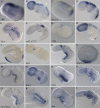
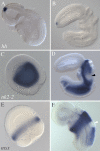
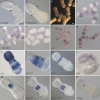
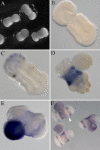
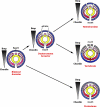
Comment in
-
Unique development in hemichordates suggests some unique features of chordates.PLoS Biol. 2006 Sep;4(9):e288. doi: 10.1371/journal.pbio.0040288. Epub 2006 Aug 22. PLoS Biol. 2006. PMID: 20076630 Free PMC article. No abstract available.
References
-
- De Robertis EM, Sasai Y. A common plan for dorsoventral patterning in Bilateria. Nature. 1996;380:37–40. - PubMed
-
- Lichtneckert R, Reichert H. Insights into the urbilaterian brain: Conserved genetic patterning mechanisms in insect and vertebrate brain development. Heredity. 2005;94:465–477. - PubMed
-
- Gerhart J, Lowe C, Kirschner M. Hemichordates and the origin of chordates. Curr Opin Genet Dev. 2005;15:461–467. - PubMed
-
- Finnerty JR, Pang K, Burton P, Paulson D, Martindale MQ. Origins of bilateral symmetry: Hox and dpp expression in a sea anemone. Science. 2004;304:1335–1337. - PubMed
-
- Martindale MQ, Finnerty JR, Henry JQ. The Radiata and the evolutionary origins of the bilaterian body plan. Mol Phylogenet Evol. 2002;24:358–365. - PubMed
Publication types
MeSH terms
Substances
Grants and funding
LinkOut - more resources
Full Text Sources
Other Literature Sources
Research Materials

